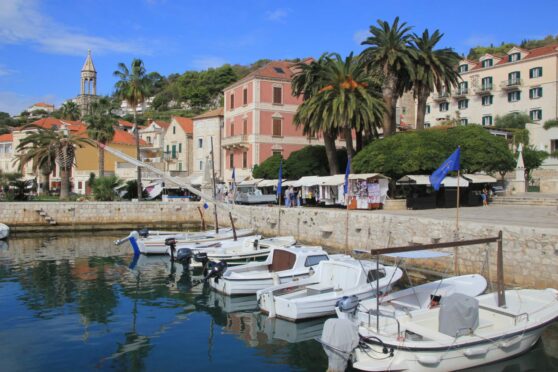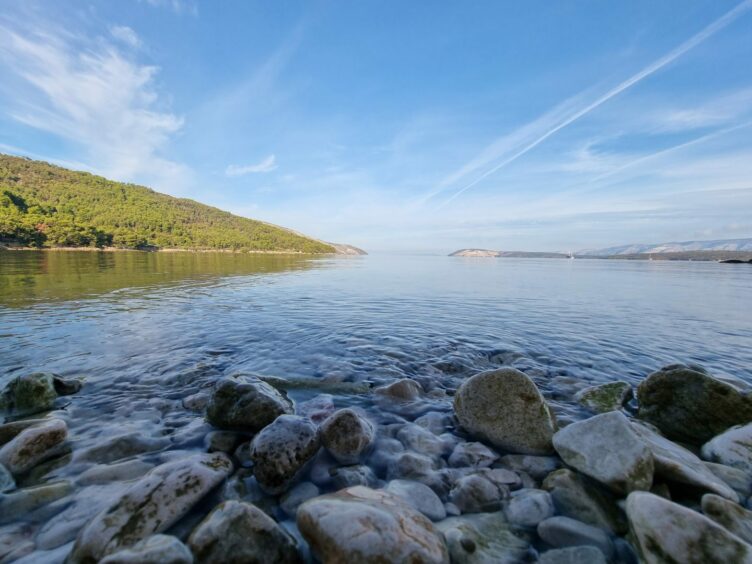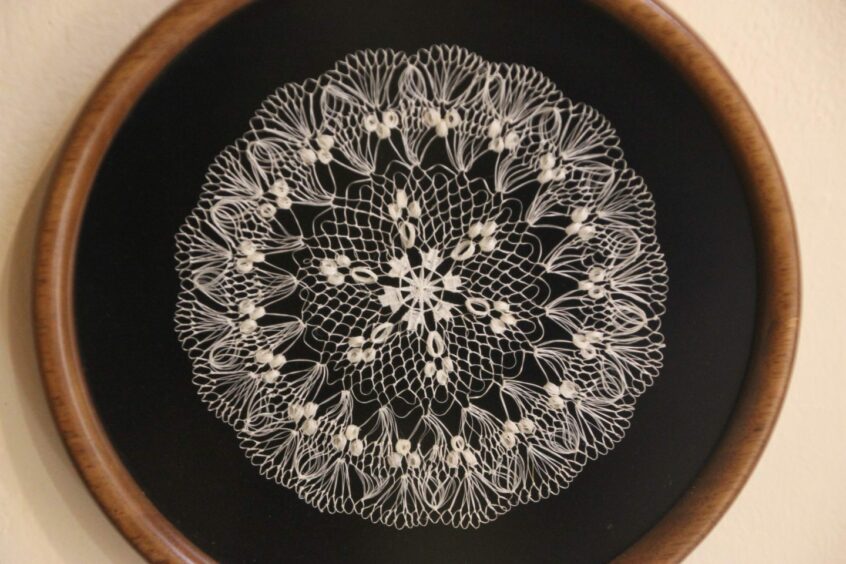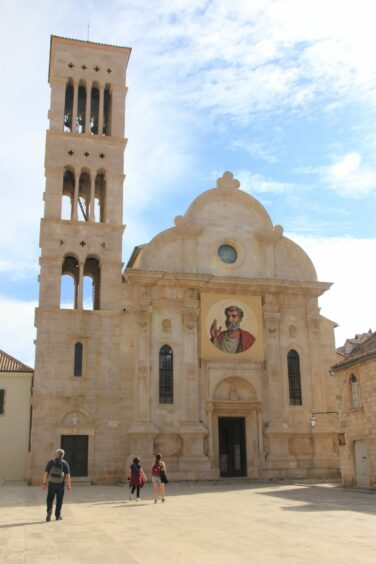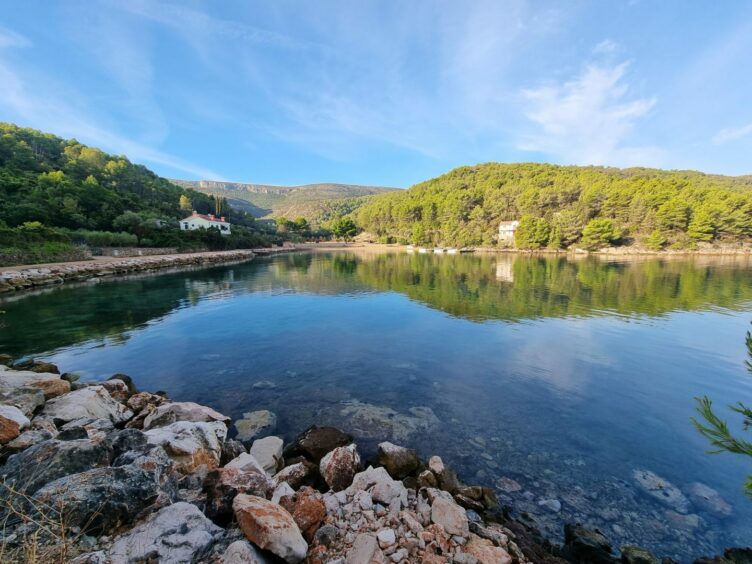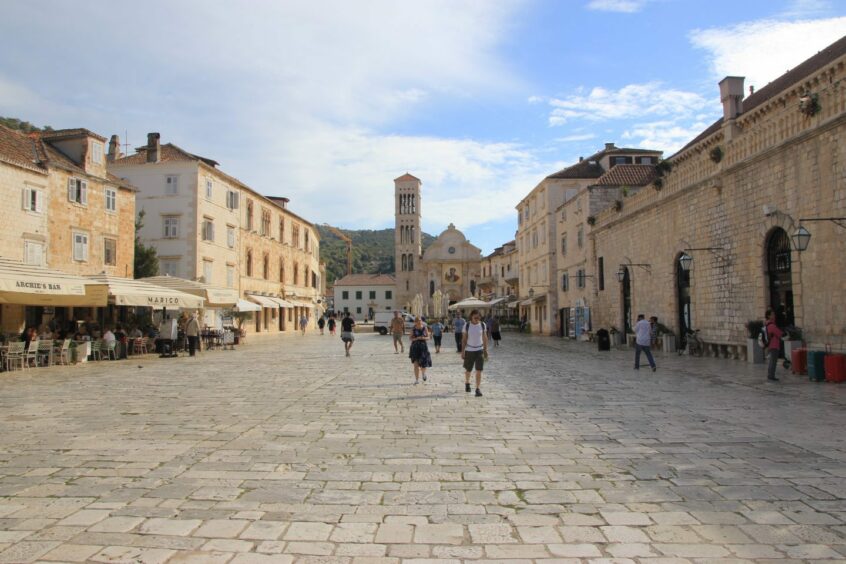Rugged rocky coasts, secluded bays and white sandy beaches with turquoise water: all of this can be found in the island world of Croatia.
Of the 1244 islands, islets, cliffs, and reefs remaining after the dramatic rise in the level of the Adriatic Sea around 13000 years B.C., only 50 are inhabited today.
So where to go on holiday? I decided on Hvar, offshore from Split, and frequented by the international jet set like Bernie Ecclestone, Tom Cruise and Michael Douglas who come for the swanky hotels, elegant restaurants and cruising opportunities.
And just like the rich and famous, I arrived in style in my own private speedboat at Maslina Resort, the latest 5 star hotel to open on Hvar, in just one hour from Split Airport (alternatively, the ferry takes about two hours).
Stunning sunsets
The property is situated in its own bay, with stunning sunsets off Hvar’s west coast, and a 25-minute walk to Stari Grad, a cluster of old stone houses built around a harbour, much-loved by yachters for its authentic seafood eateries.
The Stari Grad Plain – prime agricultural land – is a UNESCO Protected World Heritage Site. The original agricultural activity of this fertile area, mainly centered on grapes and olives, has been maintained since Greek times to the present.
Thanks to dry, chalky soils and long, sunny days, high-quality wineries offering a range of wines specific to the island have sprung up in the last few decades. “Under communism, we weren’t allowed to make our own wines”, said Ivo Duboković who runs tastings in the family wine cellar on the outskirts of Jelsa.
“All the grapes had to be sold to the cooperative so our winery is only thirty years old”. A local specialty is the orange, skin-contact wine Moja M which is 100% Maraština, an indigenous Dalmatian grape variety that can be found along the entire coastline.
Famous lace
While award-winning and successful Duboković has no plans for expansion. “It’s very hard to attract workers. There is no social life in winter. If you miss the 4.30pm ferry, you’re stuck until the next day. I call Hvar ‘my beautiful prison’”.
Solitude of a different kind is that of the nuns at the Benedictine Convent in Hvar town. The few women never go out and spend much of their time making agave lace according to the motto “ora et labora” (pray and work).
The convent was established in 1664 but the nuns didn’t start producing the delicate items until the 19th century. The work involved in preparing the lace threads is long and arduous. According to tradition, they cannot be made when the bora wind blows because the cold dry air makes them fragile. The threads are weaved into three main patterns, and the resulting lace is the symbol of Hvar.
The island was once also famous for lavender. “In the 1970s and 80s, 10% of the total world production came from here”, said local guide Dajana Moskatelo. Income from selling lavender oil financed the building of many houses, and schooling for the young generations. “But then there were several large fires, Yugoslavia collapsed, a worm wreaked havoc on the plants, and eventually many locals turned to other sources of income”.
Healing destination
Although production is much more limited now, many different products made from lavender flowers and leaves, besides lavender oil, such as biscuits sprinkled with lavender flowers, cakes coated with lavender juice or champagne with a hint of lavender are sold in shops and on stands all over the island. “Besides agriculture, fishing and viticulture, tourism is a major source of income in Hvar which began when wealthy travelers came here to cure their pulmonary diseases”, explained Moskatelo.
Thanks to the founding of the Hvar Health Society, the island has been recognized as a healing destination since 1868.
Guests can enjoy the fresh and flavorful Mediterranean diet, mild climate and salty sea air, while trekking through the heavenly scented lavender fields and rugged olive groves. Hvar is an eternal herb garden: besides lavender, sage and rosemary are found everywhere.
Going out into nature
The trend towards using local products continues to increase worldwide, and kitchens in Hvar are no exception. “It’s a balance between customer expectations and what is realistic. Avocados for the morning toast don’t grow here. Instead, I focus on going out into nature and finding something edible for our guests”, said Massimo Cvek, Executive Chef at Maslina Resort.
“And I’m continuously learning. When I first started my job it was February. I got very excited about the oranges on the trees, but then I realized very quickly that they were all bitter and could only be turned to jam”, he laughed.
The resort has its own 7,000 square metre organic garden, and mint is the most used herb. Sure enough, I found a sprig of it in my cocktail on the last evening of my trip when I watched an incredible sunset one last time.
For more information go to croatia.hr and maslina.com
Holiday facts:
Tourist info: www.hvarinfo.com/
Flights: Easyjet flies twice weekly nonstop from Glasgow to Split, easyjet.com, from £154 return. Jet2 flies every Sunday directly from Edinburgh to Split, jet2.com, from £200 return
Ferry: The route Split-Hvar is served by: Kapetan Luka, Jadrolinija, Adriatic Fast Ferries and TP Line. 14 to 20 journeys per day in high season; journey time: 50 min – 2 hours 25 min. Ticket prices: 6 to 20 Euro. www.croatiaferries.com
Stay: Maslina Resort is a luxury waterside resort in a sheltered bay near Stari Grad. www.Maslina.com
Eat, Drink, Do:
Duboković winery: www.hvarwine.com
Lavender fields: www.hvartours.com
Blue Doors Restaurant (try the cuttlefish): Trg Velo Podloža 2, 21460, Stari Grad
